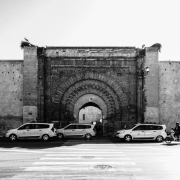Bab Agnaou & Kasbah
Bab Agnaou: The gateway to enter the Kasbah
The local population, the Marrakchi, has been moving along to the rhythm of the Djema el Fnaa square for centuries. A cadence of life and death under the influence of the different dynasties that have governed Morocco for the past 1,300 years. The special thing is that you can find their legacy in various monumental buildings in this King’s City. Enter through the gate “Bab” Agnaou, a true cultural discovery tour awaits you!
It is the most beautiful gate in Marrakech and one of 19 gates in the city. Bab Agnaou had a mainly decorative function to enter the Kasbah. When reading this word you may think of the south of Morocco where wealthy families lived in a kind of fortress: a mud-brick sandcastle with towers, bearing this name. But also one walled part in a city can be called a Kasbah and often there is something special hidden behind it!
This is also the case in the Kasbah district of Marrakech because in the 12th century this was the Royal City part of the old town. When reading about the Koutoubia, Yacob el Mansour was in power at the time. He wanted the authority of likes to portray his Almohad dynasty in impressive buildings, such as the Koutoubia minaret and the gate – Bab Agnaou. You can also find his mark in other cities in Morocco and even in Andalusia!
The meaning of the name Agnaou is still shrouded in mysteries and it is referred to by its position to the south, to the non-Berbers from the Sahara, who made their way to Marrakech. Agnaw in Berber means deaf/mute male and is associated with people who do not speak their language. It could also mean the people from the faraway country of Guinea. Yet the gate has also had a different name: Bab Leqser – palace gate. And this one seems to be more appropriate for this majestic and imposing gate.
The best time to view the gate is around golden hour. The mud walls will glow intensely red and the ingenious craftsmanship of the decorations will become even more visible in this light relief. You will also have lyrics in Kufic writing to discover. This is Arabic calligraphy at its best, and this form of penmanship was brought along with its advent of Islam from the Middle East. There used to be a tower on either side of the entrance, as well as the heads of thugs on skewers. Now in the same place, almost like an ornament, the gate is guarded by two (real) storks.
Imagine that at that time you stood in front of this gate like a stranger from afar. The world of the thousands of weaving palm trees surrounding you, you enter this city and come face to face with Bab Agnaou. Let’s think about the cannons that were only installed in the 16th century. It must have been almost surreal!
Kasbah: From Royal atmospheres to a lively neighborhood
Today the district is a lively working-class area with the Kasbah mosque in its centre, which dates from the same period when the Koutoubia originates (12th Century). At that place, like a real local, sit on a bench and take in the environment! Because this is a place for residents to catch up with acquaintances and meanwhile, neighborhood life in all its guises passes by.
On the side of this mosque, you will find a narrow passage that leads you, for a fee, to the Saadian tombs. The “forgotten” tombs of the country’s rulers between the 16th and 17th centuries. Although their El Badi palace is one impressive ruin that has fallen, these tombs of this Royal House remind you of the grandeur from their time. This beautiful example of Islamic architecture has been preserved since the tombs have been shielded for centuries. Until 1917, when the French rediscovered this special place and shared Morocco’s hidden secret with the public.
Would you like to have a drink or eat something in this area? Then visit the Kasbah Café which is opposite the Saadian digging. On the roof terrace, you have a beautiful view of the mosque and you will meet the other residents of this area: the storks. If you want to feel even more the atmosphere in this working-class district, head towards Cafe Clock: The cultural cafe of Marrakech!
The visit to this district is complete when you visit the El Badi palace during golden hour, which is down the road to Riad Orange. Read more about this special palace on our website!

 Riad Orange
Riad Orange Riad Orange
Riad Orange Riad Orange
Riad Orange